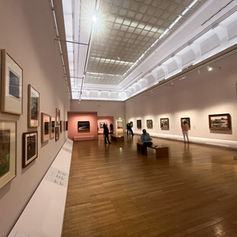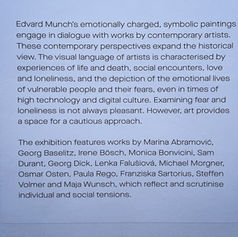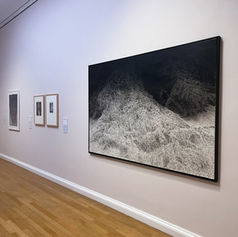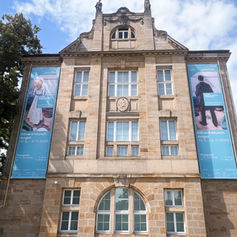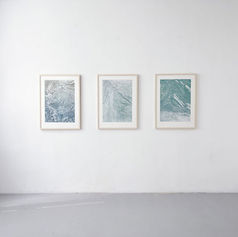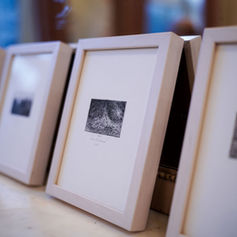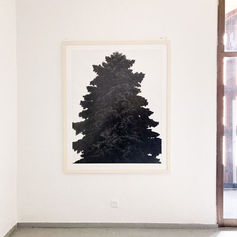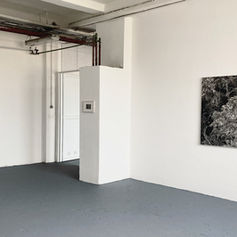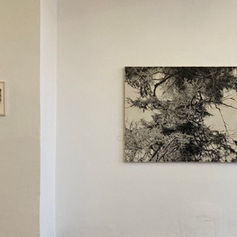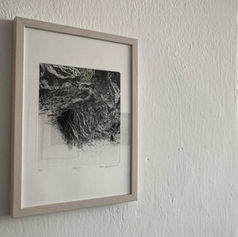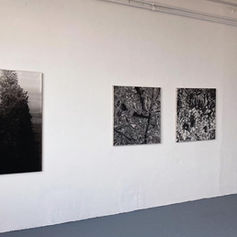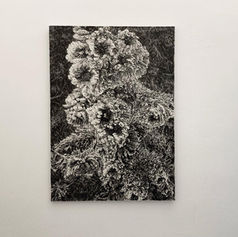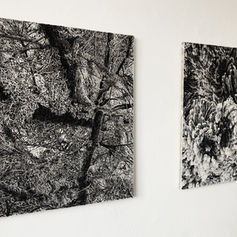Edvard Munch. Angst / Kunstsammlungen Chemnitz in Germany / 2025
Fear as a fundamental emotion is an essential feeling for survival. Like joy, sadness, disgust, surprise, anger and contempt, it is part of our human existence and is a lifelong companion. Everyone knows the feeling: the fear of failure, of losing loved ones, of losing your job and fearing for the future. It can release energy or leave us in a state of shock. Fear knows no social boundaries and affects all social groups. Fear of situations that are threatening or difficult to control, of the power and influence of internet giants, climate change, terror, change, “the stranger” and loneliness influence the way we live together. Under the motto ‘C the unseen’, the European Capital of Culture Chemnitz 2025 will not only focus on the unseen or the overlooked, but also create visions of the future. In order to define such visions, the taboo subjects of fear and loneliness must also be brought into focus and negotiated. How could this be achieved more artfully than with the works of Edvard Munch, the pioneer of modernism, who created landscapes of the soul in his paintings and reminded us to concentrate on the essence – ‘life, love and death’?
The Norwegian painter Edvard Munch was an existentialist. Through his emotionally penetrating paintings, he became a seismograph of an entire era and at the same time re-cast the foundations of art. The young artist first travelled to Germany in 1892, when he was not quite 30 years old, and remained in his chosen country intermittently until 1908. It was here that he created numerous major works, which brought the painter promotion and fame and helped him achieve his international breakthrough. His patrons also included Herbert Eugen and Johanna Esche, at whose invitation Munch came to Chemnitz in 1905 to paint portraits of the family of the industrialist for their Art Nouveau villa. His art influenced artists from the region such as Karl Schmidt-Rottluff and other members of the Brücke. Two paintings, the Portrait Herbert Esche and View across Chemnitztal, which were created at Villa Esche in Chemnitz, are on loan to the exhibition. And after almost 90 years, the work The Human Beings. The Lonely Ones, which was purchased for the Städtische Kunstsammlung Chemnitz in 1928 after several years of endeavour and sold during the National Socialist era, can now be seen in Chemnitz again for the first time as a loan from the USA.
author © Diana Kopka (curator of the Kunstsammlungen Chemnitz)

When the Rain Grows Quiet / Kvalitář Gallery in Prague / 2025
Visual artist Lenka Falušiová, who hails from the Jeseník region, is primarily interested in one thing in her work: creating spaces in which images become an interface between the visible and the imagined. In this sense, she deliberately and consistently transcends the limiting framework of the image, or rather, she consciously and consistently intervenes in its internal order. Her monochrome prints, drawings and paintings function as visual matrices; they do not depict, but rather convey – calm, structure, inner rhythm. The reduction of colour to one or two tones is not merely a stylistic gesture here, but a distinctive epistemological tool for “reading the world differently” (Johanna Drucker, 2014), for giving meaning to its chaos and changeability.
We tend to understand monochrome as a transformed excerpt from reality. In this case, however, it is more of an example of an analytical operation – a kind of aesthetic filtration that highlights the texture, depth and material graininess of the image as key variables of our personal visual experience. Just as a scientist models data to reveal hidden patterns, Falušiová models the landscape into a “visualisation of the invisible”, bringing her images closer to the concept of “epistemic credibility of the pictorial model” (Peter Galison, 1997). She is not a realist in the sense that she records the world around her and presents it to our attention as such, but in the original, philosophical sense – she believes in the world as a structure, experiences it, grasps it and stabilises it in the visual spectrum.
Trees, animals, and ultimately even the "intangible" and immaterial – yet crucial because proto-structural – represent symbolic nodes organising networks of inner experience. The forest as we know it, as we walk through it and visualise it retrospectively, dream about it, functions here as a projection screen for personal mental maps that are not exact but ecstatic – similar to “mental images born of data silence” (Frank Wilczek, 2015). It is precisely in this contemplative reduction that Falušiová finds a form of silence that is not empty, but rather saturated. “No silence is absolute; each has its own rhythm,” James Elkins ultimately reminds us in his reflections on the perception of images, i.e., artificially created visual spectra (Elkins, 1999).
In Falušiová's conception, the image thus becomes a kind of theoretical analysis put into practice, during which subjective experience is placed within the framework of rational visualisation, formation or articulation of a concept. In this sense, form is not an expression of emotion, but the result of internal structuring. The images do not show the world – they construct it as a sensory and mental model, thereby multiplying our enjoyment of them, perhaps even our fascination.
author © Barbora Kundračíková (curator)
Photographer © Eva Rybářová

30th Vladimír Boudník Award /Czech Gallery of Modern Art in Prague / 2025
Dream within a dream
Essence is the ultimate quality in the heart of the subject (Gilles Deleuze)
Lenka Falušiová's drawings and graphic art show sensitive, introverted traits. Her precise artistic expression, based on intuitive composition of the whole down to the smallest details, is introspection projected into partly found, partly imaginary natural settings. These then exhibit the characteristics of a unique, self-absorbed organism (Bush I, 2013; Forest, 2018). A graduate of the graphic studio at the Academy of Fine Arts in Prague, she studied under Professor Jiří Lindovský and Professor Dalibor Smutný, where she acquired excellent academic skills. Both mentors have previously received the Vladimír Boudník Award for their graphic work. The author's themes grow out of two basic renewable sources. The first is regular, direct contact with the great outdoors, and the second is the boundless and impenetrable realm of dreams. Both sources meet and intertwine cyclically in the ideal space of pictorial illusion (Cesta, 2023). Falušiová's primary means of expression is drawing. From this, the constitution and atmosphere of the pictorial composition grows and reveals itself. Although the drawing is detailed, precise, and descriptive, it conceals a difficult-to-distinguish interface between inspiration from the objective state of the landscape (description) and inner imagination directed toward the essence (Dream in a Dream, 2023), which speaks much more about the mood and atmosphere of an ideal place in the generalization of its undisturbed, integral nature and, from the point of view of objective conditions, its actual inaccessibility and unattainability (Touch of Silence, 2016).
Lenka Falušiová's graphics and drawings are also visual windows into the world of constant natural changes, which the author "freezes," observes, and examines (Inner World, 2015). She is fascinated by the metamorphoses of the living ecosystem, the growth of vegetation, which transforms from initial chaos into a certain order, filling the space and creating a living framework for wild fauna (Fox, 2024). Only after the movement has stopped does the "shape of metamorphosis" reveal itself as a kind of imprint of time (Light in the Forest, 2021; Relikvie lesa [Relics of the Forest], 2021). It is as if we were looking into a paradise hatchery from which life itself arises (and disappears) in hidden principles, and the author discreetly reveals these principles to us (Srdce lesa [Heart of the Forest], 2014; Lesní květ [Forest Flower], 2018).
We find ourselves in the midst of magical transformations, evoked in a non-literary and non-allegorical way, not only through perfect drawing but above all through the expressive means of dramatization, such as contrasts of light and dark (Touch of Light, 2021), or an emphasis on brightness, luminosity (choice of color) or, conversely, the darkness of graphic printing from the same matrix (The Secret of Darkness, 2014). Within a single graphic, we immerse ourselves in a case-by-case (theoretically infinite) spectrum of differently oriented essences. Behind them, we sense the abandonment of concrete, measurable time, which is transformed here into a dimension of timeless ecstasy, into something that frees the eye and, with it, human consciousness from the heaviness and anxiety that bind human existence. This is replaced by the transparency of essence (Hidden in the Rocks, 2019).
Another group of Lenka Falušiová's graphic works reflects the surfaces and structures of geological formations such as mountain or rock massifs (Prostor, 2020). Here, too, we witness a transformative effort that liberates human consciousness from the material essence of the world through sight and reflects instead the light and atmospheric conditions from which the very processes of shaping the earth emerge like mist or a dream, transformations that take place in another dimension of time (Rocks I-V, 2019). The defining feature here is the thematization of frozen movements and breaks within geological masses, which are reflected in their upper layers and, with their visual drama, contribute to blurring the boundaries between organic and inorganic nature (In the Silence of Rocks, 2019). The rocks suddenly come to life and undulate like tree crowns shaped by the wind (Mysterious Worlds of a Single Stone, 2022; Sound of the Mountain, 2022). Nature here becomes a universal place of solitude, contemplation, and meditation. The human subject merges with the surroundings, loses itself in them, is absorbed by them. The only thing that remains as a human presence here is the memory of the observer, whose contours, however, fade into involuntariness and an essence close to a dream.
One might quote Gilles Deleuze, who wrote that “the subject does not explain essence; rather, essence implies, causes, and twists itself within itself, constituting subjectivity (...) Essence is not only individual, it is individualizing (...) The coiled world of essence is always the beginning of the world itself, the beginning of the universe, the absolute radical beginning (...) Essence defined in this way is the birth of time itself. Not time already unfolded: the dimensions according to which it could unfold have not yet been distinguished, nor have the series into which it is divided in different rhythms been separated." And elsewhere, Deleuze adds: "If we look for (...) something in life that corresponds to the situation of original essences, we do not find it in any personality, but rather in a certain deep state. This state is sleep." And we are back to the dream, which is so important to the author's work.
Finally, let us recall that the talented artist Lenka Falušiová was repeatedly nominated for the Vladimír Boudník Award in 2022, 2023, and 2024 for her graphic work, which overlaps with drawing and painting. In 2025, she deservedly became its laureate, joining a number of young artists who are conquering and beneficially cultivating the contemporary Czech art scene.
author © Petr Vaňous (curator, the member of the jury)

IN SILENCES / Krystal Gallery in Havířov / 2025
Dream about the Forest
Something as classic as a simple walk through the forest. Glancing around at the beautiful and imperfect nature that boasts all its flaws and complexities. This represents the hypnotic world of Lenka Falušiová, whose centerpiece is a deep, living forest as a metaphor for the human mind. The author perceives trees as living beings whose intertwined roots and branches resemble the complexity of the human brain. Her works invite us to immerse ourselves in the structured chaos of nature, where the viewer can lose themselves in order to find themselves again. To get lost in the tangle of roots, branches, leaves, and moss. To observe deer discreetly and thus blend in completely with the surroundings. Not to stand out, to fit in, to become one. An elementary element that fits perfectly into a stable, absolute motif. To intertwine details with a seemingly superordinate disorder.
The forest landscape, inspired by the artist's feelings, memories, and personal relationship with nature, plants, and animals, conveys a necessary and unrelenting intimacy in her works. The paintings thus convey the painter's personal notes in the form of a graphic diary. The delicacy and graphic structures of natural motifs simultaneously illustrate philosophical undertones and dreamlike metaphors.
Falušiová works primarily with the technique of line etching, creating microscopic details that function as independent images. Her large-format drawings, often inspired by personal experiences in the forest, offer space for introspection and the discovery of hidden meanings. The silence of the forest, light and darkness, presence and absence—all of this is reflected in her works, which evoke both tension and calm.
The images invite us to immerse ourselves in a world where the visible becomes an image of the invisible, and where art opens up space for further expansion of consciousness.
author © Valentýna Ondřejová (curator of the Krystal Gallery)

VIZIUM Awards 2024 / Portheimka Gallery, The Chemistry gallery in Prague / 2025
The awards of the Czech Academy of Visual Arts have been given since 2021, always for exceptional artistic achievements of the previous year. Since 2024, the name of the award has changed to the VIZIUM Award. It is a Czech new term combining two meanings that reflect the values for which artists are nominated and awarded by the CAVU membership. These are the fulfilment of the “vision” in the field of visual art and at the same time the shifting of the “vision” of the discipline itself as an expressive field of visual art that is constantly evolving, changing and cyclically renewed.
The VIZIUM exhibition at the Portheimka Gallery introduces the public to the two main categories in which visual artists are awarded. These are the categories Artist of the Year and Discovery of the Year. A total of eight artists are presented here who have either won the award in the past (Artist of the Year category) or are this year's finalists (Artist of the Year and Discovery of the Year categories). From the finalists, this year's winners will be announced during the exhibition.
The exhibition spaces on the two floors of the gallery are designed differently in terms of installation. On the ground floor, Margita Titlová Ylovsky (winner of the 2022 Artist of the Year Award), Jaromír Novotný (winner of the 2023 Artist of the Year Award) and Ondřej Přibyl (finalist for the 2024 Discovery of the Year Award) are exhibiting together. The second floor, which preserves the Baroque layout of the building and the character of its decoration, comprises a total of six rooms. In five of them, Kurt Gebauer (winner of the Artist of the Year 2020 award), Viktor Pivovarov (winner of the Artist of the Year 2021 award), Jindřich Zeithamml (finalist for the Artist of the Year 2024 award), Kateřina Komm and Lenka Falušiová (finalists for the Discovery of the Year 2024 award) are exhibiting individually. The sixth room is dedicated to the presentation of the Publication of the Year 2024 category.
With this exhibition, the Czech Academy of Visual Arts gives a glimpse of the best that is happening - at least from the perspective of its members and experts - on the contemporary Czech art scene. You can look forward to works by leading artists, which include expressive means of painting, sculpture, drawing, photography and installation. The curator of the VIZIUM 2024 Prize exhibition is Petr Vaňous, who was awarded in the category of Curator of the Year (for 2022).
Discovery of the Year
Lenka Falušiová (for her participation in the exhibition Open Horizon, František Drtikol Gallery, Příbram, curated by Petr Vaňous. In 2024, Lenka Falušiová presented her work at five separate exhibitions at the Prague House in Brussels, Belgium, as well as in Prague, Uherské Hradiště, and Jeseník).

Places of Dreamers / Lenka Falušiová & Miloš Šejn / Church of St. Nicholas and St. Anne in Telce / 2025
There are places that seem to hold a secret power over us—places that enchant, that draw us in. They are places of depth, where one may discover oneself, yet just as easily become lost. Often, these are realms governed by the elements: water, fire, earth, and air—sometimes singly, sometimes in pairs, sometimes in triads. They are sites that stir the imagination, that invite reverie, where one perceives the living web of connection between all things. Dreamers are those with the sensitivity to recognize such places, to enter into their depths. And though each of us carries within a fragment of the dreamer, and though almost any place may become a place of reverie, it seems that certain sites are, by their very nature, destined for it.
Some artists belong to this lineage of dreamers, drawn to particular places and elements, as the French philosopher Gaston Bachelard once so piercingly described. Lenka Falušiová is such a dreamer of the forest, which has remained for her a primal source of inspiration, encoded since childhood in the Jeseníky mountains. For her, the forest is an image of the living, breathing world—one in which human, animal, and plant exist side by side, on the same plane. The tree, that ancient cosmological symbol, rises again and again in her works. “Trees are the guardians of the forest,” she says. Yet Lenka is not a Bachelardian dreamer of any one of the four elements; she is, rather, a dreamer of light. If Bachelard turned to the verses of great poets to reveal the imagination of the elements, Lenka’s works may serve as a path toward the phenomenology of light itself.
Miloš Šejn, by contrast, is a dreamer of the earth. His place of initiation is Zebín, a volcanic hill near Jičín, where he has lived since youth. Zebín shaped his first painterly gestures and guided his further artistic journey toward ever more direct forms of contact with chosen sites—whether in the form of imprints of terrain, the gathering and testing of natural pigments, or performative acts of intervention. And although over the decades Miloš has engaged with other elements—water among them—it seems to me that his imagination feeds most deeply on the forces of the earth. Thus, as I linger over his works, the word chthonic comes insistently to mind. From the Greek chthōn, earth, it names what belongs to the soil, the subterranean, the underworld.
The work Delimitation of Space with Fire (1982) brings together two archetypal images of humankind’s earliest imaginings: fire and the cave. Here, fire recalls not only our primeval intimacy with flame but also the cataclysmic history of the earth itself, bound to volcanic upheaval. Šejn’s cave is a chamber of reverie, opening into the depths of human history as well as into the deep time of the earth.
author © Jaroslav Anděl (exhibition angel)

STUDIO TWELVE / accompanying program to the exhibition WOMEN, MASTERS, ARTISTS / Wallenstein Riding Hall, National Gallery in Prague / 2025
Portraits of twelve contemporary female artists present socially equal and artistically confident women – creators. They were approached as representatives of specific fields of fine art, but their creative range is much broader, often transcending visual art categories. Míla Preslová, who created candid portraits of these artists in their environment, is the only one to present her photographic work in the studio. The artists expressed their views on their lives in art in a kind of motto and answered two questions: Do you feel any gender restrictions? and Can you make a living from your field? Other biographical information about the authors can be found in the links via QR codes and in printed materials.
With kind permission, we present visitors not only with the faces of the authors, but also with the richness and diversity of their artistic expressions and opinions. The following participated in the project Bára Anna Stejskalová, Lenka Falušiová, Birgitt Fischer, Petra Gupta Valentová, Monika Immrová, Karolína Jelínková, Marie Ládrová, Eliška Perglerová, Klára Pernicová, Míla Preslová, Zuzana Růžičková and Petra Vitásková.
author of the project © Jitka Handlová (curator of the National Gallery in Prague)

WAIT TILL THE MOON IS FULL / Gallery of the Prague House in Brussels, Belgium / 2024
See the whole world in a grain of sand
And the sky in a wildflower,
To clasp infinity in the palm of my hand
and eternity in a mere hour.
(William Blake, from the poem The Prophecy of Innocence)
In his philosophy, the legendary founder of Taoism, Lao Tzu, called for silence, humility, and total harmony with nature. Kuo Si, painter and author of the most important ancient Chinese treatise on the theory of landscape painting, saw this form as an important means of bringing people into contact with the real landscape, both on a spiritual and physical level. Lenka Falušiová's drawings and prints directly invite to quietly immerse oneself in the bosom of nature, to find rest and inner fulfilment. For - as Éliphas Lévi, the classic of French occultism, said - "Long observation of the sky ignites the imagination, the stars then correspond to our thoughts." Falušiová's landscape is melancholic and silent, the trees dream and the mountains breathe, the animals have stars in their eyes and the Spirit of the Forest reigns over everything.
Achieving such a profound effect in a work of art requires not only precise craftsmanship, which the artist has mastered with absolute conviction, both in ink on canvas and pen and ink on paper, but also in the complex graphic techniques of line etching and mezzotint, the creation of which has an almost sacred character for her. Another essential component is the convincing depiction of the subject matter, which in Falušiová's work springs from a personal and thorough knowledge and understanding of the workings of natural processes. Just as many great artists have considered nature to be their greatest and often only teacher, for her physical presence in the midst of nature is an absolutely essential part of her work and life, perhaps even a condition of survival itself. But it is not just a matter of sensory perception, which, according to the English painter and poet William Blake, as the antithesis of imagination, can even be an obstacle to true knowledge: "How do you know that every bird that makes its way through the air is an immense world of delight, closed to you by your five senses?" It was with works like The Conjunction of Heaven and Hell that this opponent of Enlightenment rationalism became an important precursor of Romanticism, which is also a visible part of Falusha's oeuvre, whose graphic preoccupation harkens back to nineteenth-century masters such as Rodolphe Bresdin and Gustave Doré.
An almost philosophical poetic vision is reflected in the deep forests and rocky landscapes, where here and there a more or less visible animal appears to heighten the tension between the present and the absent. The intertwined branches of the trees hide many phantoms while transforming themselves into a symbol of the complicated human brain. The drooping branches or the solitary dark tree, also a frequent element in the paintings, refer to another, this time existential level of the work, referring not only to the seductive charm of nature, but also to its threats.
The magical nature of the forest interiors reflects the author's interest in further overlaps towards mysticism, spirituality and alchemy (besides Éliphas Lévi, also, for example, the Swedish theologian and mystic Emanuel Swedenborg), towards the exploration of unusual manifestations of the hidden life of the plant world (the book The Secret Life of Plants by Peter Tompkins and Christopher Bird), and towards an interest in what comes after physical death (Raymond A. Moody, Life After Life). Despite the many sources of inspiration, however, it is always above all a personal connection with nature that, through deep concentration, opens the way to art as an expression of the spirit. In her prints and drawings, Lenka Falušiová does not depict specific places, but creates new, mythical and sacred landscapes that tell of feelings of connection with nature and time. A landscape that hides something dreamlike and supersensual. By contemplating this landscape and immersing ourselves in the deep forest, we can deepen our own consciousness, experience a fascinating journey into the unknown and discover the story of the inner landscape of the self.
author © Kristýna Jirátová (curator of the exhibition)

INTERVIEW FOR VOGUE
Les jako místo rozšiřování vědomí. Poznejte hypnotický svět Lenky Falušiové | Vogue CS

INTERVIEW FOR HARPER'S BAZAAR
Umělkyně Lenka Falušiová: Sny ví více

I Met Myself in the Forest / Artium Gallery by KKCG in Prague / 2024-25
Living surrounded by nature has brought a central theme to Lenka Falušiová's work: the motif of the deep forest. At the same time, this way of life and perception allows her to repeatedly encounter animals. Her artwork is not inspired by any one specific place. It is a collection of the artist's memories, whose new compositions create a unique forest environment. Sometimes, several characteristic places intertwine—a mythical forest, a melancholic landscape, or a place of dreams. However, all these vague places are connected by an atmosphere of silence, which is an important part of the artist's work. The forest is also a place that stimulates the imagination, which is why it inspires Lenka to make various associations. She sees metaphors for the complicated human brain in the details of intertwined branches, and when the branches tremble, she sees ghosts in their shadows.
The exhibition entitled I Met Myself in the Forest presents a series of the artist's most recent works in various formats and three basic artistic techniques: large-format ink drawings and intaglio prints, specifically mezzotints and line etchings. In her studio, she processes memories or feelings from the landscape she has experienced directly onto canvas or a graphic matrix. For Lenka, graphic work is an intimate matter that requires precision from the very beginning (preparing the matrix or working with ink, which has a specific smell). The creative process keeps the artist in constant tension. The subsequent printing is the most important moment for her, as she can directly intervene in the process—changing the image on the matrix, touching it, and experimenting. In the context of large-format works, which have become her main medium in recent years, graphic art has the function and value of a personal diary for the artist, and is therefore an important accompaniment to large drawings.
Authenticity, intuition, and precision are also typical elements of the author's work, which, combined with an unflagging desire to discover hidden stories, result in a distinctive artistic statement. This demonstrates Lenka's intimate relationship with nature and the creatures that call the forest home. The exhibition project I Met Myself in the Forest aims to encourage visitors to realize what they can experience when they find the courage to consciously become part of nature. All you need to do is not be afraid to discover stories about the external and internal – spiritual landscape.
author © Alžběta Krajčíková (curator of the exhibition and series Line of Courage)

WORLD - VIEW / Bohemian Art Space Brussels / 2024
The exhibition presents a trio of renowned Czech artists, Lenka Falušiová, Habima Fuchs and Miroslava Klesalová. The link between them is their long-standing interest in landscape, natural environment and the formation of the “image of the world”, including its hidden, spiritual or directly transcendent levels. The fuller, more complex or more elaborate the structure they create, the richer the content of what they communicate – the logical conceptual balance provides the necessary support for the ephemeral, imaginative and spiritual meanings that are related to the experience of the world. This is also related to the adopted technique – in the case of Falušiová, it is drawing and printmaking, Klesalová works with textiles and Habima Fuchs with ceramics. All of them are also thinking about the third dimension, placing the final work in a specific environment and initiating their own experiencing. The selection follows the previously mentioned presentations by Jana Kasalová and Marek Ther.
Exhibitors: Lenka Falušiová, Habima Fuchs, Miroslava Klesalová
author © Barbora Kundračíková (Art museum Olomouc, Czech Republic)

OPEN HORIZON / František Drtikol Gallery in Příbram / 2024
The exhibition project Open Horizon explores the updated relationship between contemporary visual art and space and landscape. It works with three subsets of the conceptual whole. Two are based on the presentation of contemporary painting and imagery, taking into account multiple approaches to landscape and a variety of reflective strategies, from traditional plein air painting and the construction of space to memory, fictional, imaginary, and urban landscapes. The third subset consists of audiovisual installations focused on the internal movement of landscape structures, on the reflection of their processual tectonics, but also on the performative presence "in the middle of a place" at a "specific time."
The project aims at the sustainability of a relationship with a genre that is undergoing radical change—landscape art in an expanded field. This expanded field encompasses both formal procedures and means of expression, as well as internal engagement and physical, technical, and technological intervention in the situation of place, time, and space.
Exhibitors: Kryštof Brůha, Lenka Falušiová, Marta Gruber, Julia Koudela Hansen-Löve, Filip Horyna, Karolína Jelínková, Alena Kučerová, Matěj Lipavský, Ondřej Mestek, Václav Misař, Pavel Mrkus, Michal Nesázal, Kateřina Ondrušková, Milan Perič, Adéla Součková, Miloš Šejn, Vladimír Véla, Michaela Vélová Maupicová
author © Petr Vaňous (curator)

The Guardians / Jan Čejka Gallery in Prague / 2024-25
For Lenka Falušiová, wherever there is a forest, there is a temple. Since childhood, she has been learning to read its inner order, to communicate with the communities there, both during physical visits and in her own imagination. She spends a significant part of her day there. She quietly observes. She remains. And, like nowhere else, she blends in with nature. When resting in the forest, Lenka Falušiová turns especially to the trees. She considers them guardians of what happens there. From their roots to their crowns, their branches determine the movement of everything that enters the forest. People, animals, light, wind, and water are under their protection and shade, and the shadows there take many different forms. We are talking about events that people are more familiar with from fairy tales and fantasy stories, but for Lenka Falušiová, they are real. She fills the pages of her diaries with them and also draws inspiration from them when creating her paintings.
Once, a dark figure chased her into the rocks. When she grabbed Lenka by the shoulder, it turned out to be just a dream, thankfully. However, when Lenka woke up with a start, a flock of crows was cawing on the bushes outside her window. Another time, she was watched from afar by an indeterminate mythical creature that changed shape, which, upon approaching, definitively transformed into a mere old twisted root. She also has countless "chance" encounters with animals behind her, whether it be a white doe or hundreds of butterflies, for which she became a flower for a moment. These stories have such a strong atmosphere that one prefers fantasy to rational explanation. And this is exactly what Lenka Falušiová's latest work is like. She draws and paints on a realistic basis, but not for the sake of imitation, which she has mastered perfectly. For years, she studied the diversity of branches, needles, cones, leaves, stones, and other natural objects so that she could set out in search of them. Instead of the structures themselves, she seeks something more in them—the atmosphere and beings—the spirit of the forest. Using memories and diary entries, she intuitively creates abstract scenes that convey the forest as such a complex environment that the human imagination finds itself at the limits of its capabilities.
author © Jan Čejka (curator)
photographer © Jakub Červenka

Alone in the Mountains /Gallery of the Slovácké Museum in Uherské Hradiště / 2024
Lenka was born in Vrbno pod Pradědem in 1988. The landscape of the Jeseníky Mountains became a fundamental formative element of her work, and nature her main inspiration. Lenka spends long hours and days exploring it on her expeditions, examining its structures, the rhythm of its growth, and the way different surfaces reflect sunlight. The first stage of her work is therefore observation. This is not superficial work that can be quickly dismissed or facilitated by the use of various extensions of the eye and memory, such as a sketchbook or camera. This important phase is based on careful observation and an effort to understand the essence of what is being observed, rather than on diligent memorization of what is seen. Subsequently, in her studio, Lenka uses these insights as building blocks for her prints and drawings, where, with the help of her memory but under the command of her imagination, she composes her own synthesis of the landscape. Landscapes that are archaic and quiet, inviting contemplation. This results in sections of dense forests, undergrowth, and rocks. Although these themes are treated naturalistically, from a distance they look more like abstract structures than scientific studies. They seem a bit like a search for order—some kind of repeating pattern in chaos.
Order in chaos. One of the most common clichés in science. The forest really does seem like a chaotic system. Trees, bushes, and branches in one big jumble. Such a system cannot be described using partial differential equations; that is not how we perceive the world around us. However, using our imagination, the brain seems to be able to find greater order in this chaos than classical physics. Lenka Falušiová's work demonstrates how the human mind navigates chaotic perceptions and is able to find universality in this chaos. Chaos theory and the associated fractal geometry show that with a few simple building blocks and a limited number of relatively simple rules, it is possible to create systems of infinite complexity through repetition and changes of scale. By understanding the most basic building blocks of plants, such as trunks, branches, and the rules of their growth, it is possible to create, for example, a realistic perception of a coniferous tree. By understanding how these individual trees grow next to each other so that they can coexist, it is then possible to create a realistic perception of an entire forest.All based on a simple system that is repeated endlessly, like a loop. The only limitation is the format of the paper or canvas. Art is largely how people perceive the world. Good artists have realized that there are few things that are truly important. Lenka Falušiová is certainly not the first to work in this way. The horizons of 17th-century Dutch landscapes feature realistic-looking trees and animals. However, when you look closely, you will see that it is a repetitive, trivial pattern with a few details whose combination leads the viewer's eye to the correct perception.
The exhibition at the Slovácké Museum Gallery presents a cross-section of the artist's work, including recent pieces dominated by large-format drawings and her first paintings, which are a cross between painting and drawing, with ink alternating with oil paints. However, graphic works remain the foundation of her work. These include various intaglio techniques such as etching, mezzotint, and others. For Lenka Falušiová, graphic art is like a diary. It is an essential part and foundation for her large-format works, which in turn allow her to swing more freely and relax.
author © Lukáš Malina (curator)

Territory of Silence / Contemporary Art Gallery for Jeseník / 2024
The author of the exhibition, which will launch the 2024 exhibition year for the Contemporary Art for Jeseník project, uses mainly intaglio printing techniques (line etching, mezzotint) and ink drawings in her work to capture her inner experience of the landscape and nature. She thus points not only to the increasingly frequent return of young artists to classical techniques, but also to their heightened sensitivity. The works are based on an effort to capture the individual experience of being in nature; in them we find sincere wonder, quietness and contemplation, meditation, but also a celebration of the moment. The mysticism, already present in the title, suggests the author's fondness for solitary stays in places with a strong genius loci and little likelihood of interaction with other human beings.
Despite the initial classification of Lenka's work as mimetic (imitating nature), I dare say that her work deviates from this trend thanks to its balancing act between the concrete and the abstract. Both polarities, growth and decay, coexist here. Trees, forests, landscapes—nature in general—are depicted in the form of structures representing both the visible and the merely intuited. The motifs thus appear very concrete at one moment and attack the viewer's imagination at the next. On closer inspection, the clusters of lines are undoubtedly not just a random composition, but rather the bearer of nature's internal order, which is at once chaos and an organized whole. Each work contains multiple layers, giving the pieces a certain temporal dimension. The effort to capture an elusive and relatively abstract perception, based primarily on emotions, and the fact that this is ultimately done in a very concrete way (and in black and white) is actually an interesting plot twist.
When depicting forest structures, Falušiová proceeds from detail to the whole, but not in a unidirectional manner. We are also encouraged to alternate between immersion and distancing by the format, in which drawings on a two-meter canvas alternate with miniature-sized graphic prints. The reduction of scenes that are themselves details offers an interesting formal game. Sometimes, the captured structures, with their photographic composition, can resemble only a momentary blur that flashes before one's eyes and quickly disappears.
The graphics are like a diary for the artist, and the choice of time-consuming techniques, which Lenka has been using since she started creating art, speaks to the contemplative nature of her work and thinking. Her experience of the landscape is reflected in her focused and patient work, which seems to give shape to what she has already experienced. The image here functions as a memory trace and, through contemplation of the landscape, invites us to turn our attention back to our own inner selves. Entire mountain ranges or just details of organic structures emerge from the shades of gray. This could easily give us the impression that the entire world could be pieced together like a puzzle from the depicted segments and structures. All the nooks and crannies, every leaf, branch, and even entire forests seem to have become an irreversible part of the artist herself during the time she devoted her attention to them. Lenka Falušiová's artistic work is then only a projection of these carefully stored inner images, and the "territory of silence" is, rather than a physical place, a space where the author's mind goes when she creates.
author © Kristýna Krutilová (painter and curator)

Silver waters flow over the steps of the forest / Caesar Gallery in Olomouc / 2023
When the peaks of our sky come together,
My house will have a roof.
– Paul Éluard, Dignes de vivre, 1944 –
Lenka Falušiová belongs to the generation of artists who in recent years have rediscovered the charm and richness of landscape art. By ‘rediscovered’, I mean she has embraced landscape art’s original essence, i.e. it’s primary ability to grasp the world, primarily the human world; after all, we are talking about art, about human creativity, about human perspective. The landscape [sic]. But also about the amazement and overwhelming sensation that Nature provokes in our minds, and our subsequent efforts to make sense of it all. We have lived with a chronic fear of destruction for the past few decades, as if we can no longer imagine the landscape without knowledge of the imminent end of the world. But as Hercule Poirot, that quintessential product of industrialised society, aptly remarked somewhere in the field, there is no end to nature and there never will be. This is what people like Lenka Falušiová show, and, after all, isn’t this why we even have artists? Simply walk into the forest and surrender yourself to its wonder. You will be reminded of the magnificence of the universe faster than you can say ‘a priori form’. We should only be worried about ourselves.
And yet, I don’t want to limit my thoughts on Lenka's current work from 2023 and her first bold venture into space to subtle criticism of premature dystopianism or to a celebration of the complex nature of being, let alone landscape art per se. Instead, I would like to trace its blossoming and consider the possibilities of imagination, creativity and – perhaps somewhat paradoxically – ritual practice, the echoes of which resonate strongly here.
For my purposes, I adapt the triple frame, medium, ritual and performative turn, relying on Bachelard's concept of spatial geometry, specific in its strict dialectic. That is why, as is known, Gaston Bachelard himself rejected it so pointedly – his goal was to restore a solid connection between what we understand as internal and external, our own and foreign, precisely through the geometrisation of our own spectrum. And I intend to follow in his path. Naturally, this is much easier for me, because the call for a holistic view of the world we inhabit is one of the loudest today, with the up-to-date performative turn being its actual driving force – it shows that everything that is ‘stable’ and ‘fixed’ is only this way temporarily and for our purposes or need, while from a long-term perspective it is subject to a spontaneous process of transformation and negotiation. In other words, a concept is a tool that we create as we walk through a terrain that is constantly changing beneath our feet – simply because, like us, it is alive.
What does ‘ritual’ have to do with any of this? We typically see the ‘magic’ that is part of ritual as an irrational attempt to interpret the behaviour of a universe whose character we have no access to. This we do on the basis of our own experience, the limited framework in which we move on a daily basis and in which individual elements or segments gradually become symbolic nodes. I refer in this sense to Roger Collingwood, though in other respects, especially in the conception of art, I digress. According to Collingwood, magic is based on three propositions – first, I create an emotional bond to objects in my environment, which I thereby domesticate; second, I begin to understand these objects as symbols; and third, these objects are interpreted as symbols, i.e. as couplers of emotions, not only by me but also by members of the community in which I live. Magic, a ritualised practice, does not pursue a logical explanation of concrete acts, let alone a ‘solution’ to them; its purpose is to facilitate the release of emotions. Magic is controlled emotional escalation.
One of our first critics of media (reproduced media, moreover), Walter Benjamin, linked the rise of photography (and the graphic arts) to a turn towards ritual practice. Benjamin wrote: ‘For the first time in the history of the world, technical reproducibility emancipates the work of art from its parasitic dependence on ritual.’ Why? For one thing, because the original disappears in the tangle of copies, and thus its initial, unquestionable connection with transcendence disappears. And yet we know that the material, the object, continues to hold this quality. Important here is the physical experience of ‘holding’, which is repeated. It is a repetitive grasping of a fact of life, which gradually becomes a symbolic reality, first individually, then shared – as Collingwood explains. And it is this repetition that is the key to understanding the relationship between ritual and performative practice. Even the process of negotiation takes place over and over again, albeit with variations, and on a substantive basis. At the same time, as Daniela Hodrová states, ‘the body describes certain symbols with its movements, attitudes and gestures; it does not interpret them, but realises and experiences – it experiences the cosmos in the body’.
As such, we are also reminded of the principle of Gesamtkunstwerk, a ‘total work of art’ produced by the 19th century in its hunger for the perfect illusion and increasingly rejecting the original source of sovereign delusion, God and religion. Much has been written about the nature of ceremonial rituals viewed from an anthropological perspective. These are characterised by a high degree of ritualisation, reflection of a specific location or time of day, but above all repetition. Unlike the original instrumental or ordinary behaviour that inspired them, ritualised movements and sounds become ‘extraordinary’, thereby drawing our attention. They are usually simplified or stereotyped (formalised), intense with the characteristic regularity of tempo. The signals are often exaggerated and are further developed in the following action, space and time. A work of art in the Western tradition has exactly the opposite nature – it is novel, original, does not recognise or directly disqualify repetition, and is intended for presentation. It breaks free from everyday practice by transcending it. In Lenka's case, however, I see ritual not in opposition to art or only as an expression of emotional relief, but in its essence as a rational attempt to comprehend and cope with what is seen. Finding a structure or an order that may not be stable, but is remembered. It is precisely in this context that I perceive a high degree of courage and experimentation in her work, by which she encourages us, the viewers, to not only respond emotionally but to actually think. When I mentioned in the introduction her effort to move into the third dimension, into space, it was meant very concretely – the surface of the image becomes a thoughtful installation materialising the principle of an eternally establishing structure that has no fixed core or limits. If she uses the label ‘sanctuary’ for it, she is deliberately leading us by the nose and having a little fun, even at her own expense.
Bachelard’s literary duology The Poetics of Space – and – The Poetics of Reverie: Childhood, Language, and the Cosmos, which is mentioned here in almost every respect and which has profoundly influenced our thinking about the experience of our own being, is based on the aforementioned dialectic of the inner and the outer. The entire richness of the intimate world of being is fixed in the ‘here and now’ – in the simple localisation of a safe place or one's own dream. However, the ontological absolutism to which this thinking leads apparently overlooks the inherently ‘rounder’ complexity of being. Bachelard uses the phrase ‘windows of fancy’ to refer to them and leads the reader beyond the limit of the internal/external, which – according to him – is intimately connected to the geometrisation of the space in which we exist. ‘In terms of geometric expression, the dialectic of inside and outside rests on an intensified geometricism in which limits are obstacles. We must remain free from any categorical thinking – and geometricism records categorical ideas,’' he says, suggesting that even centralisation itself is only temporary. ‘A spiral being that appears from the outside as a well-encircled centre never actually reaches its centre. Being human is being free from fixation. Every expression frees a person from fixation. As soon as an expression is raised in the realm of imagery, being already needs another expression; it must be the being of another expression.’ In other words, we achieve the greatest sense of belonging in the world when we – at least temporarily – resign ourselves, our originality and uniqueness, our centrality.
author © Barbora Kundračíková (Art museum Olomouc, Czech Republic)

VI. GRAPHIC CABINET / 8smička – art zone, collector's apartment 7+1 in Humpolec / 2022
The work of Lenka Falušiová, an illustrator and graphic artist who studied at the Graphic Art Studio I under Prof. Jiří Lindovský at the Academy of Fine Arts in Prague, is inextricably linked to nature. Her cutouts from dense forests, steep rocks, or diverse stones are like windows in a film strip. They exist independently, without any need to relate to their surroundings, and at the same time they awaken our curiosity to explore their entire world. The trees and rocks on Lenka's paper come to life. The contrasts of light and shadow make us feel, almost tangibly, their living structure and carefully examine their space.
In the graphic arts cabinet, the author presents works (line etching, mezzotint) from the series Dunění skal (The Roar of Rocks, 2019–2022). The exhibited prints represent abstract forms of various structures in their precise execution. They are not specific, accurate records of natural objects, but feelings preserved within her. Pieces put together, with which Lenka gradually builds an entire world. At first glance, the surrounding stone landscape resembles the environment of a celestial body with no sign of life. But when we immerse ourselves in it, at least in the little piece of land that the author brings us, we feel life. The energetic ornaments of nature.
Every stone, even the smallest and seemingly uninteresting one, hides several secrets. Its immobility brings us peace, and at the same time, its hardness shows strength. In large quantities, it can evoke a feeling of hopelessness, but also a feeling of infinite beauty when we realize that each surface is unique in its shape. Rocks are witnesses to and agents of the Earth's development. Thanks to Lenka's overlapping dynamic lines, we can quietly read their script.
author © Anežka Chalupová (curator of the 8smička Gallery in Humpolec)
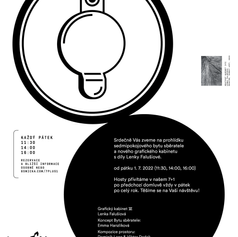
IMMERSION / Contemporary Czech gallery Art in Šumperk, Czech Republic / 2022
Lenka Falušiová‘s work is compact, complex and coherent. Rarely is it possible to say with such assurance that what we see here is an expression of a mature imagination. Lenka’s work has undergone significant development and further development lies ahead. However, there is a solid core one can lean on securely. This, I think, is what we find so attractive about it. There is a certain tension – between the form and the content, between the manner of work and what it demonstrates. After all, this exhibition is entitled Immersion and it is about immersion, however, at the same time, more than anything else, it evokes the opposite process, the process of emersion.
The landscape and the landscape structures have always been a subject depicted in art. To a certain extent they are related to the evolution of man - they are connected with our sense of direction. However, beside the external space, equally often they are an impetus to explore our inner space within. On the one hand, their function is didactic, on the other hand, they are deeply romantic; they search the finest recesses of the soul for the really big, transcendent subject of art. They demonstrate the process, for which Maurice Merleau-Ponty used the term intentional arc and Martin Heidegger the term Dasein. Both of them are heading in the same direction – of naming the basic condition of our existence in the world, i.e. the body and bodily experience. In the sense of Merleau-Ponty‘s thinking, the body is the tool for the immersion „within“, inside the things, the stories, their own existence. According to Heidegger, the acceptance of the body‘s own temporary nature is the condition of being that is authentic and reconciled with itself.
In this context, Lenka‘s strategy of work is interesting for two reasons. Firstly it is a combination of drawing and graphic art, two delicate techniques that resonate with the body and its natural movement probably the best – a hand grasps an object that is seen, transforming and restoring the object to an existence in a different spatiotemporal scale. This process follows precisely the process or cognition or recognition. Secondly, it is the manner of capturing, creating the structures that are only seemingly intuitive. Without a good measure of knowledge and experience, we could never achieve a comparable result. It is obvious that Lenka‘s eye as well as her hand know exactly what they are doing. And this is what leads me to a conclusion.
Bruno Bettelheim, an Austrian-born psychologist, used the motif of a forest to describe the processes in the human mind. In a study dedicated to fairy-tales he wrote: „Since ancient times the near impenetrable forest in which we get lost has symbolized the dark, hidden, near impenetrable world of our unconscious. If we lost the framework which gave structure to our past life and must now find our way to become ourselves, and have entered this wilderness with an as yet underdeveloped personality, when we succeed in finding our way out we shall emerge with a much more highly developed humanity.“ For a long time this way out was being offered by aesthetics - through our senses we penetrate to the nature of things, which is then grasped by thought, image, which others can relate to. In this sense, a work of art, the supreme expression of human creativity, maybe even of human being itself, may be called truthful in its nature. A little cut-out thereof that Lenka Falušiová contains, a cut-out defined by the span of her personality, suddenly becomes much more significant. It is not necessarily true in the logical, explicatory sense, but it is true in the global sense – as an expression of aspiration for the truth rather than the truth itself. By letting us watch her aspirations in a generous way, Lenka gives us an opportunity to see much more than it originally appeared. She gives us an opportunity to emerge from the forest unscathed.
author © Barbora Kundračíková (Art museum Olomouc, Czech Republic)

VANITAS / DOX Center for Contemporary Art in Prague / 2021
Vanitas explores death and dying, an important theme in contemporary art. The approach toward death (and life) has varied throughout human history. In modern society, death and dying are gradually being pushed aside, to the point of becoming almost taboo. Art, however, has never completely abandoned the theme. In the Renaissance era, the popular way of depicting the transience and futility of human existence was through still lifes, featuring such motifs as flowers and the human skull. Such motifs and themes have periodically re-emerged in art ever since, with the skull-and-flowers motif being the most common, yet still open to new, original interpretation. Flowers and skeletal remains are clear, intelligible symbols which easily convey their universal meaning, especially when juxtaposed in this manner: together, they symbolize the beauty of life, which is in stark contrast to human death and suffering. In many cases, however, they can form a strange harmony, where death becomes beautiful and life/nature is the symbol of human misery. The skull, as a symbol of radiant death, is in sharp contrast to the melancholy of wilting flowers, together forming an allegory of old age and dying.
Vanitas presents the works of more than 60 artists spanning several generations and a variety of genres, from painting and drawing to graphic arts, from photographs to sculptures, installations or conceptual projects.
Exhibiting artists: Barbora Balek, Josef Bolf, Erika Bornová, Veronika Bromová, David Černý, Jiří David, Jiří Georg Dokoupil, Tereza Eisnerová, EPOS 257, Lenka Falušiová, Jan Gemrot, Martin Gerboc, Václav Girsa, Matouš Háša, Siegfried Herz, Josef Hnízdil, Tomáš Honz, Monika Horčicová, Kryštof Hošek, Martin Janecký, Jakub Janovský, Petr Jedinák, Tomáš Jetela, Václav Jirásek, Josefína Jonášová, Krištof Kintera, Svatopluk Klimeš, Simona Krausová, Milan Kunc, Hynek Martinec, Jan Mikulka, Martin Mrkva, Robert V. Novák, Eugenio Percossi, Jiří Petrbok, Ivan Pinkava, Daniel Pitín, Miroslav Polách, Ondřej Přibyl, Michal Rapant, Tomáš Rasl, Lukáš Rittstein, Jaroslav Róna, Aleš Růžička, Martin Salajka, Jenny Salm, Marek Schovánek, František Skála, Vladimír Skrepl, Adéla Součková, Michal Škapa, Marek Škubal, Barbora Šlapetová, Jakub Špaňhel, Richard Štipl, Dagmar Šubrtová, František Štorm, Jan Švankmajer, Eva Švankmajerová, Mark Ther, Anna Tretiagová – Krajčová, Teri Varhol, Tomáš Vrana, Jan Vytiska, Richard Wiesner, Martin Zet
author © Otto M. Urban (DOX curator)

MAGIC OF THE FOREST / Felix Jenewein Gallery in Kutná Hora / 2021
Few contemporary artists in the field of graphic art display such fanaticism and dedication to the formal aspects of their work as Lenka Falušiová. Compared to her, I can think of only one equivalent in the person of Michal Cihlář, who has been demonstrating similar dedication for years in the field of color linocut. Obviously, this is a way to gain a permanent and unmissable place on the contemporary scene.
We will probably place the emphasis mainly on the word drawing, which is a discipline requiring the absolute foundation of everything that makes someone an artist. First and foremost, the ability to pay attention, be perceptive, concentrate, and, in the deepest sense of the word, have a philosophical view of what is being depicted. Also, a desire to understand all the connections and relationships, not only the obvious ones, but also the hidden ones. Lenka Falušiová has gone so far as to study esoteric literature, and thus, not only through drawing, but also through her thoughts, she strives to uncover the deepest contents of nature's hidden secrets.
In the vast majority of cases, an artist's childhood and the age at which their views on everything around them are formed play the most important role in shaping their opinions. Lenka Falušiová was born in Vrbno pod Pradědem and was therefore close to the mountainous landscape of the Jeseníky Mountains, where she drew her first inspiration. She has now moved to the Posázaví region, which offers a similarly rich landscape. From the way she chooses her themes and visual details, it is clear that she does not deal with landscape views as a whole, but is absolutely absorbed by the detail and depth of the internal structure of plant organisms.
Perhaps we will understand more if we quote the author: "The forest scenery is full of structures, tension between order and chaos – this is the inspiration for me from the landscape where I come from, the Jeseníky Mountains. It is a melancholic, mysterious, and quiet landscape. I perceive this silence as emotional and intangible, its touch is one of the main moments of my paintings. The visible arises from the manifestation of the invisible, the impenetrable forest is full of twilight, in which the details of the branches emerge from the darkness into the light. The space I see has no boundaries; the monumental whole, full of tremulous details, becomes an intense contemplation, almost "in detail" – but it is precisely this microscopic "insignificance" that opens the gate to the perception of the whole, of the universe. It was only through frequent wanderings in the woods and observing them that I gradually began to perceive the inner chaos they evoke as order. It was almost as if I had acquired a kind of inner vision, a secret key to understanding. If the darkness is calm, the light will move – this is also the title of one of my graphic prints. For me, the shape of matter is an imprint of memory and feeling. In the solitude of the landscape, I learn to see sharply into the distance, to harmonize with the pulse of nature and breathe in its rhythm. The more time I devote to these forest motifs, the more the essence of place and time penetrates them. I am fascinated by the tension between genius loci and imagem loci. I find their link in objects, in stones, trees, flowers, in every living organism. It is essential to perceive their space of existence. To tune in to the power of silence, to the necessary inner peace. At such moments, I feel that everything is connected and that I am part of the whole.
The exhibition Magic of the Forest captures a selection of the author's work mainly from 2017-2020, but we can also find older works from 2014. In addition to graphic prints, which are dominated by larger formats such as Space (2020), for which she won the Graphic Art of the Year 2020 award, and the etching In the Silence of Rocks (2019), the excellent ink drawings on canvas, such as the monumental work Imperceptible Worlds (2020) and the contemplative Sensory Space (2021).
author © Aleš Rezler (Director of the Felix Jenewein Gallery)

Deep in the Forest / František Drtikol Gallery in Příbram / 2020
When rocks begin to glow and move, you can hear the whispering of stones and trees talking about your own secrets.
Lenka Falušiová is a forest walker, and in her large-format drawings and prints, she leads us into the world of the Jeseníky mountain firs, a region of vast, natural coniferous forests, into the cold landscape of the Jeseníky Mountains, where it often rains and strong winds blow, and in the highest parts, the climate is like that of the Arctic Circle. But the artist spends most of her time in the primeval forest near the Bílá Opava waterfalls, where centuries-old fir trees grow. At first glance, it may seem that old fir forests are the same as spruce forests, but, as she herself says, fir trees are not as susceptible to bark beetles, and above all, they have a different, more lively and wilder shape...
She enjoys the wildness; it is "a forest where no human foot treads, a dark thicket that speaks with a deep sound." Somewhere deep inside, the heart of the forest beats quietly. However, in these forests, it is possible to disappear, get lost, and encounter incomprehensible phenomena. The careless can perish in the bushes and decaying leaves, among mushrooms that no one has picked, becoming part of the forest's undercurrent, the underground mycelium. We understand the forest as a very complex ecosystem. It is a living forest, constantly changing and evolving in perfect harmony with all the plants, trees, and organisms that complement each other and thus enable their existence. The close links between the individual parts of this complex system constantly influence and transform everything. The birth of one is conditioned by the demise of another.
It is precisely this kind of living forest that can be found in the work of Lenka Falušiová. The delicate lines and hatching of ink drawings and line etchings never begin or end, yet the forest emerges from them in impressive beauty. Her paintings appear supremely realistic, yet they are not. The artist spends long days walking along obscure forest paths, observing carefully, seemingly seeing ordinary things, but seeing a great deal. Only at home, according to the rules of lines and their rhythms, do forest structures grow under her hands, as her sensitive perception recalls them. Visual hierarchies emerge, branches, a network of branches, and the entire crown of the tree. In the chaotic, fractal structure of the forest, the background suddenly recedes and delicate cascades of branches, graded by light and contrast, leap forward. The scratched dark ink areas vibrate in space, and the gaze naturally sinks into their depths and returns. Somewhere in the shadows, a silent nocturnal creature explores its surroundings with its tactile whiskers.
It is as if we can hear the frequency of sound, the music of the forest, conveyed to us by a unique kind of visual perception. The shapes of the branches are not precise, but they tremble with light and deep night shadows, and some forest interiors even hide fairies or unicorns. It is a mythical forest, an archaic sacred forest that tells of feelings of connectedness with nature and time. And it is the same forest that the priest and graphic artist Arnošt Hrabal wandered through when he worked in the parishes of Jeseník. His Moravian Jeseník forest was compared to the late-fantastic medieval forests. Yes, I also perceive a subtle parallel with the legacy of the dreamy priest Hrabal, who found the sacred in the dim light of the trees, in a landscape where the forests rustle eternally.
author © Radka Schmelzová (DAMU, Prague)

Silent Presence / Lašské Museum in Kopřivnice / 2020
You are walking through a deep forest. Sunbeams fall on you sporadically and only for a few brief moments. You do not perceive the forest as a whole, but only its individual sections. A branch. Foliage. A narrow view of the sky. Pine needles. It is as if a film reel is slowly unfolding before you. Frame by frame. Suddenly, you are blinded by a bright light. For a few seconds, you cannot see anything; everything is plunged into white darkness. Instinctively, you close your eyes. After a moment, the most prominent objects appear on your retina. The outlines of a tree in the middle of a clearing, the lines of a muddy path, a feeding trough. It takes a few more minutes for your eyes to adjust to the midday sun. As a farewell, you turn back for a moment to look at the trees. Where you could previously make out every branch, you now see only darkness, this time black.
The fundamental theme of Lenka Falušiová's work is nature. However, Lenka approaches nature differently than most of us. Her perspective is not primarily ecological, economic, cultural-historical, or touristic. For her, the value of nature does not lie in its connection to humans and their needs, nor in its usefulness (whatever that may mean). For Lenka Falušiová, nature has value in itself; for her, it is a partner that we cannot subjugate in any way, we cannot impose our order on it, nor can we ever fully understand it. But we can quietly observe it, we can live side by side with it, and we can try to find order and meaning in the apparent chaos of its existence. What meaning? It's hard to say...
But Lenka Falušiová is not only interested in the physical natural world that surrounds her. She knows very well that everything around us is just an illusion of our senses. But how can we penetrate this visual dream? Perhaps the best way is to try to get to know it in detail, to uncover its secrets. But not in the manner of natural scientists. Artists, for the most part, are not equipped for that. Nor is it in their interest.
In her work, Lenka attempts to capture what her eye actually experiences in various situations. Her graphics reveal to us, step by step, not only what we see, but also how we see it. Our eyes and brains deceive us; the visual impression that is the end result of the complex process of seeing is a smooth image adapted to our everyday experience. When we observe with this awareness, everything around us suddenly takes on a completely different form, a different meaning (or non-meaning).
A forest in the fog? Several unorganized, blurred objects in space. A view from darkness into light? First, an absence of any visual information, and then only a slow and incomplete revelation of what is seen. A piece of rock? An infinitely detailed, stunning structure, full of lines, twists, and hollows. Dawn among the trees? A blurred, elusive structure, full of gray tones. This is (probably) what raw vision looks like, which Lenka Falušiová attempts to capture—from the eye directly onto paper.
author © Pavel Dvořák (curator of the Lašské Museum)

INSCAPE / U Prstenu Gallery in Prague / 2019
She flicks her words like lit matches. They drop delicately, burning.
- Kate Tempest, The Bricks that Built the Houses
In his book dedicated to Francis Bacon, Gilles Deleuze talks about the third eye, the haptic, tactile eye that sees in this way. Visuality, as we have understood it for the past few decades, is something quite different. We are a visual society—but definitely not a figurative one, as demonstrated, among other things, by the overuse of sight as an expression of a concrete, distanced, i.e., manipulative attitude toward the world, which, of course, cannot be touched, does not smell, does not make a sound, and has no taste. All the hedonism of metaphor, of movement in the intuited, the unclear, in color, in space, has been replaced by the transparency of the senses, the correctness of the concept, the conviction that the complexity of living can be summed up in a positive finding. Such waste! Such deprivation!
Every system is a matter of setting internal boundaries. Landscape and inscape. The first is external, the second internal—the first can be seen, the second felt. Intuitively, there is a similar contradiction between the optical and the haptic as there is between the imaginative and the fantastical. The first is shared and detached, the second personal and beyond control. The former is intended for communication, the latter for experience. What happens when inscape becomes landscape? If the optical/haptic pair is associated with Alois Riegl, who used it to describe (material) relief art, and Deleuze, who applied it to Bacon's sensual painting, the imagination/fantasy duo fantasy first appears in Thomas Coleridge's reflections on the limits of cognition and later in Roger Scruton, who used it to attack ostentatious (pornographic) photography. With this in mind, I reflect on Lenka Falušiová's works, on their graphic basis, on her freehand drawings and graphic prints, on the breadth of the spectrum that they not only show but, above all, make us feel. Her work is based on an infinite number of details, fragments, and units that together create a solid structure, a system, a cluster—chaos—a tangle. It demonstrates diversity, evoking both concentration and overload. And it calls for silence, because it uses the delicacy of suggestion, layering, slow revelation (of itself). It is not a structure of signs, it is not a linear system. I am not looking for either of these things here – and I do not find them either. What fascinates me is the fullness of space. The way it can handle it, i.e., the absence of the concrete and its revocation. The eye glides over the surface, sinks, falls, gropes, searches—and finds. It becomes hybrid, a third: the contradiction between the tactile and the optical does not exist.
author © Barbora Kundračíková (Art museum Olomouc, Czech Republic)

Text from the New Wave catalog, graduates of the Academy of Fine Arts in Prague / National Gallery in Prague, Trade Fair Palace / 2017
At first glance, Lenka Falušiová's work may resemble that of Julius Mařák. Like Mařák, Falušiová captures the "interior of the forest." Compared to Mařák, however, her prints depict a forest without distinguishable tree trunks, without views of the sky, and, so to speak, without an exterior. The layout of clearings and thickets, light and darkness, creates a mysterious impression. While, according to Mark Fisher, the Freudian unheimlich "processes the outside through the cracks and debris of the inside," the eerie allows us to "see the inside from the perspective of the outside." The mysterious is typically found in a desolate landscape, where it develops around something absent, or around the presence of something that defies definition. It is precisely this tension between the present and the absent that plays out the dynamics of Falušiová's forest prints. Obviously, this is not a simple duality. In this regard, we can recall Douglas Crimp, according to whom the English word "presence" has three meanings: something present, something actually absent (such as a ghost), and finally something more than present. Such excess could perhaps be called the spirit of a place, which Falušiová's prints undoubtedly capture.
Even this seemingly simple statement can be elaborated upon. Today, the term genius loci refers to a kind of special atmosphere of a given place. In ancient Rome, however, genius loci was understood as a spirit guarding a particular place. Falušiová retains something of this archaic concreteness in her prints. In reverse translation, rather than genius loci, we could speak of imago loci, whereby imago in Latin means not only "image" but also "specter." In this case, "image" is not merely a reproduction of what is seen. Falušiová draws from memory, and her inner landscapes and corners are thus also projected into her graphics. The "ghostliness" of the depicted places is further enhanced by the knowledge that they reflect the artist's native Jeseníky Mountains with their dark witchcraft past. Unlike witch hunts, however, Falušiová's hunt for the spirit of the place is not directed at the burning border, but rather at the disappearing relationship with nature.
author © Vojtěch Märc (art historian)

The Spirit of Place / Jiří Jílek Gallery in Šumperk / 2015
The perfect chiaroscuro (here, perhaps, light emerging from darkness) stems from the inner glow of a delicate range of shades and the richness of the print colors. With its almost photographic precision, it is reminiscent of the forest photographs of Bohumír Prokůpek (1954-2008), more a painter than a photographer, or even the photo-thickets of Petr Zinke (*1966), which are indistinguishable in their graphic conception.
The sharp engraving, focused on tree branches, represents the forest in its entirety. The seen and the dreamt intertwine and merge into one. Lenka herself mentions her dreamlike empathy with the motif. Despite the faithful representation of the subject, she is not concerned with descriptiveness. She aims for the borderline of hidden corners of consciousness. In some places, it evokes anxiety and the unease of Váchal's visions, Munch's paintings, or rather Trakl's "soft veiling of the mind." In a state of self-forgetfulness (in concentrated coexistence and identification with the motif), however, an infinite space of freedom opens up to her during the drawing process. And resting in the soft silence of the purifying solitude of the forest leads her to the core, to the center, to the soul of nature in its pure transparency.
The first thing that comes to mind are the aquatints by Jitka Chrištofová (*1977), a graduate of Vladimír Kokolia's studio. The mutual proximity is obvious here. Jitka's position is more objective, and the living forest tissue is silently reflected in it. Lenka's is noticeably more epic; we sense a story hidden behind the image. It is its expectation. A joint exhibition would be excellent, and they would certainly understand each other.
Lenka's choice to study under the civilly restrained Jiří Lindovský and Dalibor Smutný, with his almost portrait-like flowers from the night garden, is also a happy one. The subconscious influence and obvious moral support of both are beneficial to her. It gives her confidence, leads to humility and perseverance in her respect for the craft. This makes it easier for her to resist the pressure of current short-lived global trends.
Encountering Lenka's testimony and her direction into the depths is a joy. It reaffirms that nothing disappears, that it returns with new life and persists despite all doubts. That boredom is only an inner emptiness and that reality is inexhaustible.
author © Miroslav Koval (gallery curator and artist)

